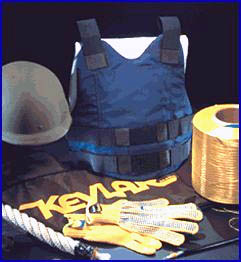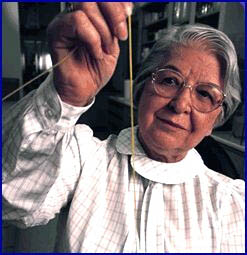Stephanie Kwolek and Kevlar
by Andrew Boyd
Today, not-so-shining armor. The University of Houston's College of Engineering presents this series about the machines that make our civilization run, and the peoplewhose ingenuity created them.
"A damsel in distress rescued by her knight in shining armor." A romantic cliché, though it's hard to imagine anything very romantic taking place with the knight covered in metal. Body armor was thick and heavy. But that changed in the late twentieth century, thanks to a pioneering damsel.
 Stephanie Kwolek was born in New Kensington, Pennsylvania in 1923. Her father kindled her interest in science at an early age. Together, father and daughter studied plants and animals around their home. From her mother, a homemaker, the young girl developed an interest in clothing design. Both skills would prove useful in later life.
Stephanie Kwolek was born in New Kensington, Pennsylvania in 1923. Her father kindled her interest in science at an early age. Together, father and daughter studied plants and animals around their home. From her mother, a homemaker, the young girl developed an interest in clothing design. Both skills would prove useful in later life.
In college, Kwolek majored in chemistry with the goal of attending medical school. But when medical school proved too expensive, she interviewed for a chemical research position at DuPont. The work was so interesting she never left.
In 1965, at age forty-two, Kwolek was working in the laboratory looking for a strong, lightweight fiber to strengthen automobile tires. And she was successful beyond anything she could have imagined. What she discovered was a material that, pound for pound, was five times stronger than steel. The material? Kevlar.
 Body armor has seen many advances since the days of medieval knights. The military is always seeking better ways to protect foot soldiers. What made Kevlar so revolutionary was that it's a polymer fiber, like nylon. When layered, it's strong enough to stop bullets. Yet it's light enough to be comfortably worn as part of a police uniform. Kevlar isn't good at stopping sharp objects, like knives or ice picks. And the human body absorbs a lot of a bullet's energy. Imagine being kicked hard, really hard, in the chest.
Body armor has seen many advances since the days of medieval knights. The military is always seeking better ways to protect foot soldiers. What made Kevlar so revolutionary was that it's a polymer fiber, like nylon. When layered, it's strong enough to stop bullets. Yet it's light enough to be comfortably worn as part of a police uniform. Kevlar isn't good at stopping sharp objects, like knives or ice picks. And the human body absorbs a lot of a bullet's energy. Imagine being kicked hard, really hard, in the chest.
But Kevlar and similar products are continually being refined. And their use isn't limited to body armor. They're used in the manufacture of rope, car brakes, sports equipment — even musical instruments. And all thanks to the ingenuity of Stephanie Kwolek.
"[When I first discovered Kevlar, the polymer] solution was very different from the standard polymer solution," she said. "It had a lot of strange features. I think someone who wasn't thinking very much … or took less interest in it … would have thrown it out." But Kwolek didn't. And her work has saved thousands of lives.
Kwolek's efforts haven't gone unnoticed. In 1994, she was inducted into the National Inventors Hall of Fame — only the fourth woman to receive that honor when it was conferred. But, of course, awards aren't what motivated Kwolek. "I love doing chemistry," she said. "And I love making discoveries."

I'm Andy Boyd at the University of Houston, where we're interested in the way inventive minds work.
D. E. Brown and J. Burke. Inventing Modern America: From the Microwave to the Mouse. Cambridge, Massachusetts: The MIT Press, 2003.
Stephanie L. Kwolek. From the web site of the Chemical Heritage Foundation: https://www.chemheritage.org/classroom/chemach/plastics/kwolek.html. Accessed April 7, 2009.
Picture of the gloves taken from the web site of the Occupational Safety and Health Administration web site. Accessed April 7, 2009. All other pictures are from the web site of the Smithsonian Institution.